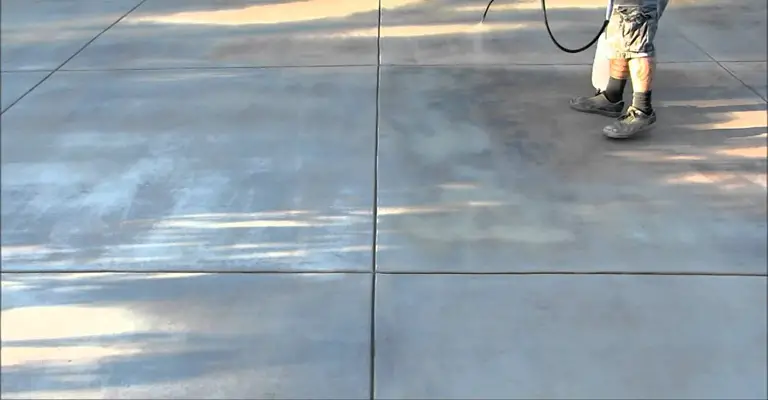Have you ever wondered why your concrete looks so dark grey? There are a few reasons behind this color: the materials used, how the concrete was made, and even environmental factors.
Let’s delve into the factors that might be causing your concrete to have that dark grey appearance.
Dark grey discoloration in concrete is caused by cement that has been hydrated to varying degrees. This phenomenon occurs because the moisture content of concrete varies in localized areas.
Why Concrete Turns Dark Grey?
Generally, home builders and homeowners don’t like discolored concrete, especially in driveways. These discolorations look like dark grey patches…somewhat rounded, about 1″ to 6″.
The first thing to come to mind is that they’re probably oil drippings from work vehicles.
The surface seems wet at first glance, but closer inspection reveals it’s dry. This leads to speculation that something in the concrete leaches up through the surface to cause a darker color.
It’s common for dirt to get encased in concrete during the concrete placing process. Why does it usually come from there? What do you think? Workman’s boots, non-uniform grading, concrete truck tires?
Interestingly, every inspection I’ve done at that ready mix plant has always included a look at the aggregate stockpile.
I’ve never found it to be the source. Almost all concrete clumps get floated/finished over with a relatively thin layer of mortar fraction.
In some cases, the layer is just ¼”. There’s no sign of dirt anymore. Now, the surface looks good. The concrete looks good for a short time, but it sets in seconds.
If you have concrete that’s 4″ thick, there will be more moisture in it than if you have mortar behind the dirt clump that’s ¼” thick.
This thin layer of mortar will be drawn moist by the dirt ball and the air above. For the slab to get its color, it must have the right amount of moisture and curing/drying conditions.
Resulting in dark spots (thin mortar coverage…low moisture content) and lighter surrounding areas (full thickness slab…high moisture content) due to higher and lower water-cement ratios.
An example of light versus dark areas in slabs could be: a hard steel trowel finish is going to be darker than a slab with a wet, floated surface…the more you trowel, the less moisture….the darker it looks.
Regarding dirt clumps, the thin layer of mortar covering them usually cracks and crumbles within a few months, especially when vehicle traffic starts. When you do this, you usually expose the dirt. When holes go unrepaired, weeds usually start growing in them.
Common Causes Of Discolored Concrete
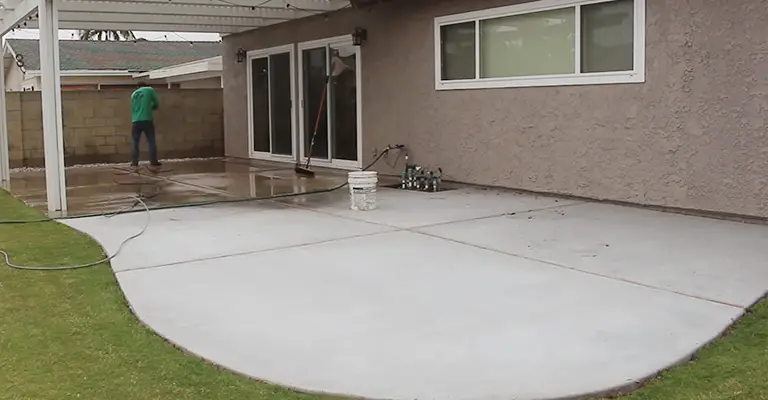
Discoloration is a tricky problem since many things can cause it (see picture).
Consistency is the root cause of discoloration in concrete placements, no matter how sequential. You can get this if your materials aren’t consistent, or your workmanship isn’t good.
Check out these causes and practices that lead to discoloration and some remedies you can try.
Poor Workmanship
In concrete placement, how a contractor reacts to variables, like changing weather conditions from morning to afternoon and day to day, will make a huge difference.
You should wet down your subgrade before placing your slab in a dry environment.
A concrete slab placed in a hot, humid climate may also require windbreaks, evaporative retardants, or other practices.
Adding Calcium Chloride
Adding calcium chloride to concrete to accelerate setting is a common reason for darkened concrete, especially when calcium chloride dosages get close to 2%.
It’s easy for the concrete color to become blotchy or irregular if it’s not mixed well after adding calcium chloride.
Using Cement Replacements
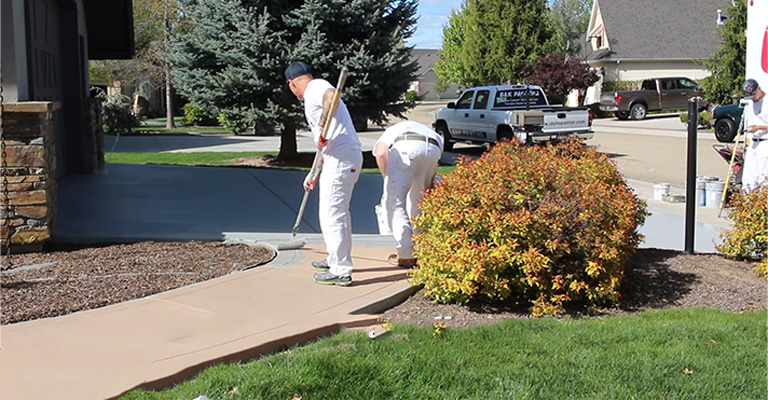
Color issues get complicated by the trend to go “green” and substitute recycled stuff for cement, which can change colors a lot, depending on how much recycled material you put in there, how much water you add to cementitious materials, and how you cure it.
The most common recycled cementitious material (SCM) is slag, a byproduct of steel, and fly ash, a byproduct of coal combustion.
You can get everything from buff to brown depending on how much fly ash you use. The color of the slag can initially be slightly blue or green, but it lightens as time goes on. You’ll generally get lighter concrete if you mix slag and cement.
Change In Cement Color
The cement delivered to the ready-mix plant can vary slightly depending on how the cement is burned or ground.
If you replace or adjust the cement during an ongoing placement or you put this adjusted mix next to concrete made with different cement, you may see a color change in the concrete.
Adding Water At The Jobsite
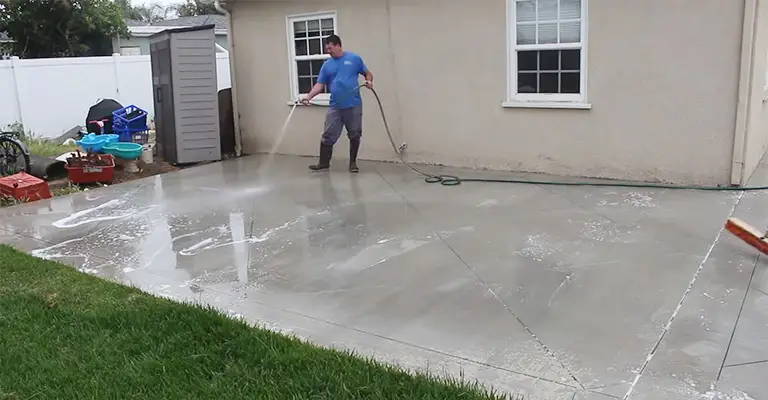
To make finishing operations easier, contractors sometimes adjust batch moisture contents (which translate into workability) on site.
There are usually no issues with small variations in concrete moisture. Modifying the mixes in the field and mixing them inefficiently can cause blotches.
The shade changes in side-by-side placements are really noticeable, particularly when water is added after one batch, and then the concrete is placed next to a batch that wasn’t retempered.
Inconsistent Materials
Keeping color proportions consistent throughout the project is the key to avoiding objectionable color issues.
A uniform concrete surface color is tough to achieve when the mixes drastically differ from batch to batch.
You should depend on your ready-mix provider to deliver a consistent mix. There’s more to it than that since concrete contains many different ingredients with different properties.
A cement mix includes cement, supplementary cementitious materials, sand, stone, water, admixtures, and maybe fiber, and ensuring consistency from batch to batch is no accident.
The American Society for Testing and Materials (ASTM) rules say all concrete ingredients must be tested. A good aggregate is essential for concrete.
Depending on the moisture content of the sand and stone, adjust the mixed water amounts. A failure to do so can have serious consequences in the field.
How to Keep Concrete from Turning Dark?
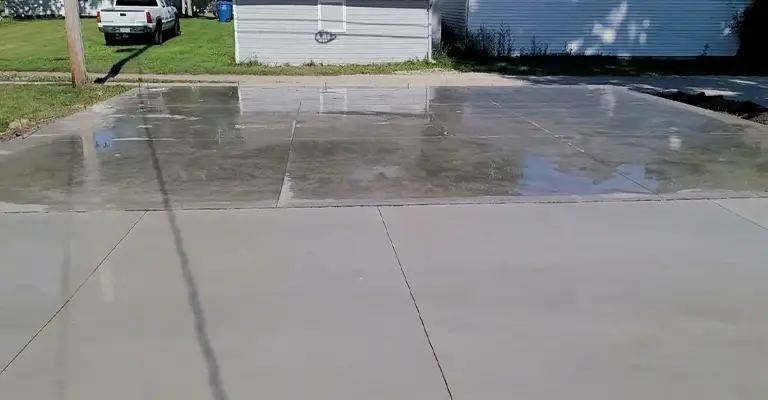
You can prevent your concrete from turning dark. Remember, prevention is better than cure.
Laying down cement mix just requires you to be aware and constantly careful.
It’s moisture that’s your main enemy, and moisture comes from many places.
Water levels were different in the two batches; the weather was weird, and the workmanship was bad. To stop your cement from going dark, don’t let it dry out.
If you’re making multiple batches for the same project, keep track of how much water is used in the first batch.
Another option is to ensure you can finish the entire project in a single batch. You can use more water if you want your cement to be light but be careful not to make it too porous.
Regarding the weather turning concrete darker, you’re dealing with dry weather since it takes away moisture.
To avoid dry weather damage, you can moisten the subgrade (the floor underneath the slab) before setting it. A windbreaker or an evaporative retardant could also help.
If you’re not using calcium chloride, your concrete will turn dark through improper technique.
Commonly, calcium chloride is used to accelerate cement drying, but it causes the cement to get darker.
Another thing that could make your cement look darker is trowel burning. You’ll get a darker cement mix because trowel burning evaporates the water from it.
Also, getting a contractor who knows how to lay cement properly is the best way to deal with poor workmanship.
There are some things you can do to avoid color discoloration. But if the damage has already been done and your concrete has turned dark, don’t fret. Getting rid of the dark color on your concrete is actually possible.
Are There Any Advantages To Having Dark Cement?
You’re probably reading this to figure out how to get rid of the dark cement color.
It’s important to note the advantages of darker cement before you read the conclusion and go with lighter cement.
Concrete with a darker color doesn’t necessarily have any significant advantages. More moisture is at play here. It’s because of the lower water content in the cement mix that dark cement colors appear.
In the same way, light-colored concrete comes from a higher water content. Besides color, moisture makes a difference in how porous and solid your concrete is.
If you add too much water, the concrete will be porous and prone to breaking. If you add too little, it will be hard to work with, and improper mixing will also make it unstable.
In other words, a darker color might mean your concrete is more solid as long as everyone in the mix absorbs all the materials. Additionally, it’s important to define dark concrete.
Don’t let concrete turn dark (unless you’re paving a road). A dark color can show up when darker spots are next to lighter ones, making the dark spots look relatively dark.
Thus, darker spots shouldn’t necessarily mean they’re less desirable than lighter ones.
It can be a problem when there are dark spots or darker discoloration on your concrete from spills that could indicate that it has been damaged.
In Summary
There are lots of reasons why concrete can get discolored. These factors range from moisture levels to spilt foreign materials. Several factors can happen because of the builder, like negligence.
Therefore, when preparing for your project, you’ve got to make sure you choose a cement mix provider/brand that you’ll be able to count on.
When you don’t trust yourself to work alone on the project, you should go with someone with experience.
Remember to consider subfloors and hot weather when mixing since they can affect moisture levels.
You don’t need to add calcium chloride or hard trowel to the project to rush the process. In either case, it’ll end up darker and uneven.
You can get rid of dark concrete using many liquid mixtures, most of them containing acid.
The problem is, they don’t guarantee to work, especially when troweling hard materials. Concrete alternatives should not be used if you’re aiming for even coloration. “Green concrete” can have unpredictable discoloration.

